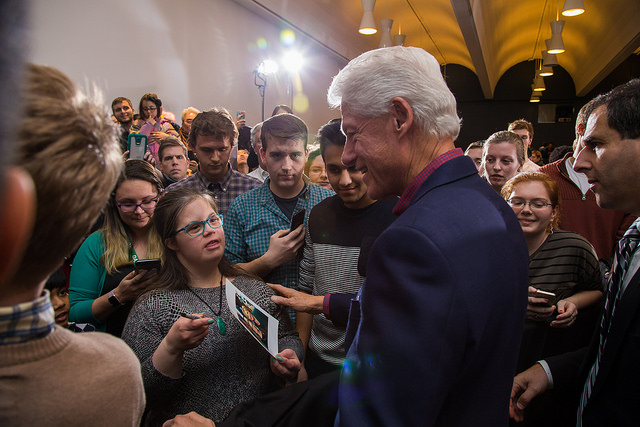
By arrangement with Robert Reich
Why did the white working class abandon the Democrats?
The conventional answer is Republicans skillfully played the race card.
In the wake of the Civil Rights Act, segregationists like Alabama Governor George C. Wallace led southern whites out of the Democratic Party.
Later, Republicans charged Democrats with coddling black “welfare queens,“ being soft on black crime (“Willie Horton”), and trying to give jobs to less-qualified blacks over more-qualified whites (the battle over affirmative action).
The bigotry now spewing forth from Donald Trump and several of his Republican rivals is an extension of this old race card, now applied to Mexicans and Muslims–with much the same effect on the white working class voters, who don’t trust Democrats to be as “tough.”
All true, but this isn’t the whole story. Democrats also abandoned the white working class.
In some respects, Democrats have been complicit in the vicious cycle of wealth and power that has rigged the economy for the benefit of those at the top.
Democrats have occupied the White House for sixteen of the last twenty-four years, and in that time scored some important victories for working families – the Affordable Care Act, an expanded Earned Income Tax Credit, and the Family and Medical Leave Act, for example.
But they’ve done nothing to change the vicious cycle of wealth and power that has rigged the economy for the benefit of those at the top, and undermined the working class. In some respects, Democrats have been complicit in it.
Both Bill Clinton and Barack Obama ardently pushed for free trade agreements, for example, without providing the millions of blue-collar workers who thereby lost their jobs any means of getting new ones that paid at least as well.
They also stood by as corporations hammered trade unions, the backbone of the white working class. Clinton and Obama failed to reform labor laws to impose meaningful penalties on companies that violated them, or enable workers to form unions with a simple up-or-down votes.
I was there. In 1992, Bill Clinton promised such reform but once elected didn’t want to spend political capital on it. In 2008, Barack Obama made the same promise (remember the Employee Free Choice Act?) but never acted on it.
Partly as a result, union membership sunk from 22 percent of all workers when Bill Clinton was elected president to fewer than 12 percent today, and the working class lost bargaining leverage to get a share of the economy’s gains.
What happens when you combine freer trade, shrinking unions, Wall Street bailouts, growing corporate market power, and the abandonment of campaign finance reform?
In addition, the Obama administration protected Wall Street from the consequences of the Street’s gambling addiction through a giant taxpayer-funded bailout, but let millions of underwater homeowners drown.
Both Clinton and Obama also allowed antitrust enforcement to ossify–with the result that large corporations have grown far larger, and major industries more concentrated.
Finally, they turned their backs on campaign finance reform. In 2008, Obama was the first presidential nominee since Richard Nixon to reject public financing in his primary and general-election campaigns. And he never followed up on his reelection campaign promise to pursue a constitutional amendment overturning “Citizens United v. FEC,” the 2010 Supreme Court opinion opening the floodgates to big money in politics.
What happens when you combine freer trade, shrinking unions, Wall Street bailouts, growing corporate market power, and the abandonment of campaign finance reform?
You shift political and economic power to the wealthy, and you shaft the working class.
Why haven’t Democrats sought to reverse this power shift? True, they faced increasingly hostile Republican congresses. But they controlled both houses of Congress in the first two years of both Clinton’s and Obama’s administrations.
In part, it’s because Democrats bought the snake oil of the “suburban swing voter”–so-called “soccer moms” in the 1990s and affluent politically-independent professionals in the 2000s–who supposedly determine electoral outcomes.
Democrats would have to stop obsessing over upper-income suburban swing voters, and end their financial dependence on big corporations, Wall Street, and the wealthy.
Meanwhile, as early as the 1980s they began drinking from the same campaign funding trough as the Republicans–big corporations, Wall Street, and the very wealthy.
“Business has to deal with us whether they like it or not, because we’re the majority,” crowed Democratic representative Tony Coelho, head of the Democratic Congressional Campaign Committee in the 1980s when Democrats assumed they’d continue to run the House for years.
Coelho’s Democrats soon achieved a rough parity with Republicans in contributions from corporate and Wall Street campaign coffers, but the deal proved a Faustian bargain as Democrats become financially dependent on big corporations and the Street.
Nothing in politics is ever final. Democrats could still win back the white working class–putting together a huge coalition of the working class and poor, of whites, blacks, and Latinos, of everyone who has been shafted by the shift in wealth and power to the top.
This would give Democrats the political clout to restructure the economy–rather than merely enact palliatives that papered over the increasing concentration of wealth and power in America.
But to do this Democrats would have to stop obsessing over upper-income suburban swing voters, and end their financial dependence on big corporations, Wall Street, and the wealthy.
Will they? That’s one of the biggest political unknowns in 2016 and beyond.

